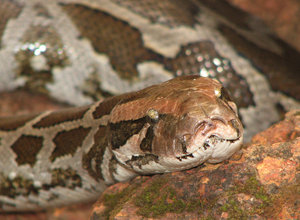ANIMAL: Indian Python Python molurus Type of Animal: Boa/Python Habitat: River valleys, woodlands, forests, grasslands, swamps, marshes, rocky/semirocky foothills, scrubland, scrub forest, savanna, mangroves, semi-desert, agricultural areas, caves Location(s): E Pakistan, most of India, Sri Lanka, Bangladesh, S Nepal, S Bhutan, & possibly Burma Appearance: Whitish/yellowish w/ blotched patterns varying from shades of tan to dark brown, specimens in E coast of India fairly light, specimens in W Ghats & Assam darkest, pinkish/almost pinkish head, albino yellows available in captivity, females larger than males, light colored belly, short tail w/ dark yellow & black reticulations, triangular head Food/Diet: Rodents (including larger species), birds up to size of cranes, other snakes (including smaller members of own species & venomous snakes), lizards up to size of water monitors, turtles, tortoises, smaller crocodilians, amphibians, civets, otters, rabbits, hares, fish, carrion, monkeys, deer, pigs, cats, dogs, bear cubs, goats, mongooses, foxes, newborn calves, sheep, leopard cubs, fishing cats, caracals, jungle cats, clouded leopards, tiger cubs, wildcats, gibbons Status in Wild: Stable Conservation: Breeding from zoos, private breeders, & reptile centers Lifestyle: Solitary Additional Info: Called: Male Female Young-Snakelet Group-Solitary Weight: Male-70-80 lbs Female-100-120 lbs Young-20 lbs Gestation: 2-3 months Life Span: 20-30 years Body Length: Male-9-10 ft Female-12-14 ft Young-5 ft Tail Length: 1.5 ft Main predators of adults are tigers, crocodiles, leopards, & large monitors (sometimes eaten by snake in fights to death. Monitors more often go for young). Clouded leopards, other snakes (including larger Indian Pythons), monitor lizards, large hornbills, caracals, fishing cats, eagles, hyenas, & pigs prey on young. Kills prey using constriction, swallowing prey whole. Hunted for skin, meat, & out of fear. They’re ambush predators. Also called Indian Rock Python, Black Tailed Python, & Asian Rock Python. Referred to as Ajingar in Nepali, Ajgar in Hindi & Marathi, Ajagara in Odia (language spoken in parts of India), Azdaha in Urdu, Awjogor/ Meghdombur/Megdum in Bengali, & Pimbura in Sinhala. Females can lay up to 100 eggs in a clutch. Fun Fact(s): This species may not need to eat for a whole other year after a huge meal. While not venomous, they can give nasty bite if provoked. Kaa from the Jungle Book was an Indian Python. They tend to be fairly docile snakes.
